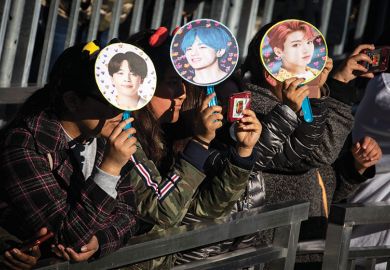I must be getting old, for I was shocked by the title of this book, Introducing Cultural and Media Studies: A Semiotic Approach - the idea that one could blithely collapse these fields into one, as if they were more or less the same thing. Also troubling is the suggestion that either field could be encompassed by "a semiotic approach", semiotics being only a small component of each.
However, faced with the question of how to introduce cultural or media studies, one has to admit that semiotics does clearly convey the power of media institutions in culture and of cultural meanings themselves.
It therefore implies the ethical and political importance of studying media and culture. In this regard, Introducing Cultural and Media Studies conveys the ways in which meaning is produced in and as "power".
Focusing on visually mediated culture and linguistic discourses, and revealing all as sites of power/ knowledge, interpellation and so on, this book will surely seize the imagination of new undergraduates. It will prove helpful to teachers, too, not least because it includes comprehensive exercises and further activities within each chapter. It could therefore constitute a complete course resource.
But one could say that it in effect takes the thinking out of teaching semiotics. Moreover, it omits a lot: there are far too few and too scanty references to the politics of race, class, gender and identity, to ethics, political economy or any production other than the "production of meaning" in acts of reading pages and screens. Yet I would still recommend the book.
For first-year modules it offers a very good nuts-and-bolts user's guide to semiotics that will also be of value to more advanced students.
Beyond the introductory level, one should perhaps turn to Antony Easthope and Kate McGowan's A Critical and Cultural Theory Reader . The new edition of this 11-year-old text, which has stood the test of time, remains ideal for more advanced study. Also beginning with semiotics, there are then excerpts from Ferdinand de Saussure, Roland Barthes, Pierre Macherey and Colin McCabe; passages on ideology from Marx, Louis Althusser and Edward Said; on subjectivity by Jacques Lacan, Julia Kristeva, Michel Foucault and Barthes; on gender by Freud, Hélène Cixous, Laura Mulvey and Gayatri Spivak; on postmodernism from Jean-Francois Lyotard, Fredric Jameson and Jean Baudrillard; and on "Documents in cultural theory" by F. R. Leavis, Theodor Adorno, Raymond Williams and Tristan Tzara. The selection is judicious and valuably supplemented by thorough commentaries that contextualise and clarify the debates and issues and the importance of each excerpt.
Though today there may be many readers in and around cultural and media studies, Easthope and McGowan's remains vital. Perhaps it could be updated slightly. But there is a case for saying it should remain exactly as it is: a historically important document in cultural theory.
Paul Bowman is lecturer in cultural studies, Bath Spa University College.
Introducing Cultural and Media Studies: A Semiotic Approach
Author - Tony Thwaites, Lloyd Davis and Warwick Mules
Publisher - Palgrave
Pages - 240
Price - £47.50 and £15.99
ISBN - 0 333 97248 1 and 97247 3
